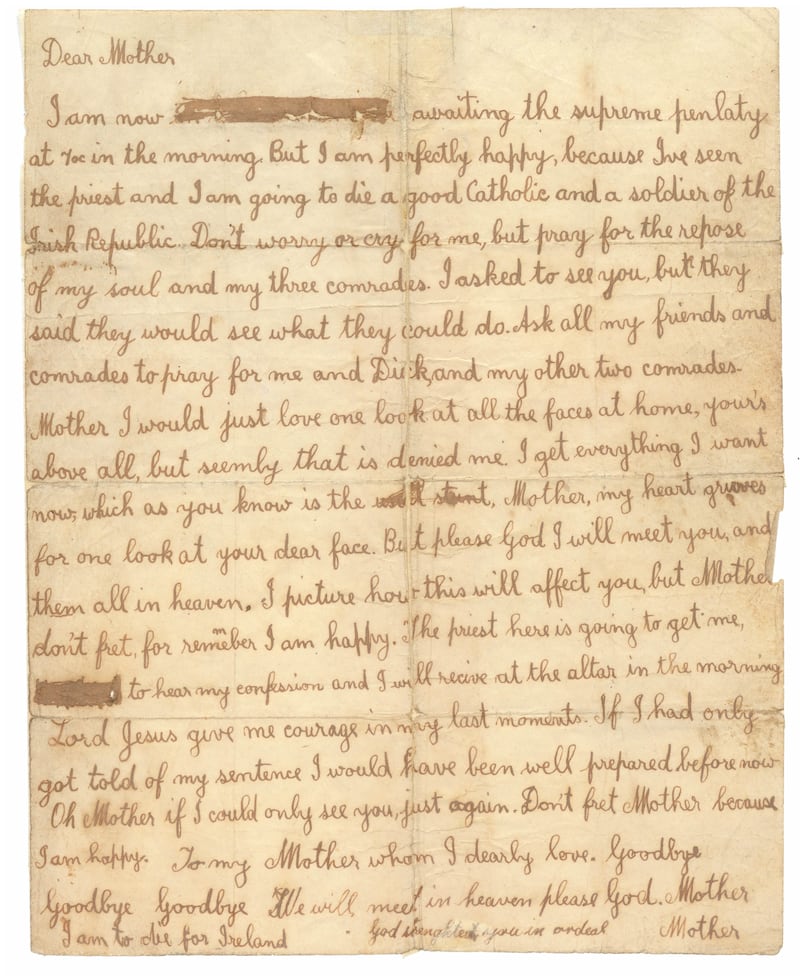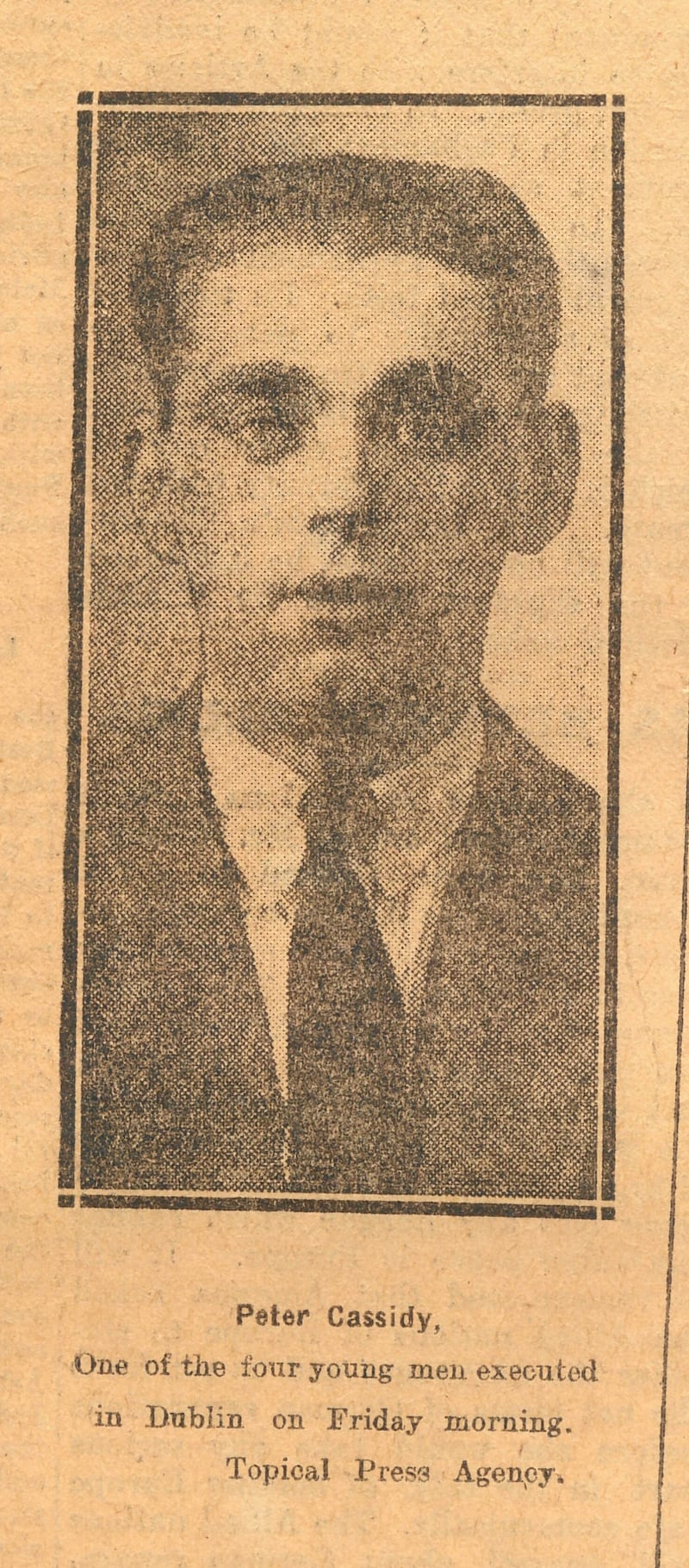In Kilmainham Gaol near the archway to the Stonebreakers Yard, where the leaders of the Easter Rising were executed, is a plaque which many visitors do not notice.
It remembers four men who were executed in what was the old female exercise yard, on November 17th, 1922 – James Fisher (18), Richard Twohig (19), John Gaffney (19) and Peter Cassidy (21).
They were barely adults when they faced the firing squad at 7am that morning – the first executions of the Civil War. It was thought better to execute them together than apart. The National Army company selected to do the shooting did not do a good job.
They had no experience of this grisly business and many were assured their rifles were loaded with blanks so they might believe they were not the ones to fire the fatal shots. Cassidy had to be finished off with a coup de grâce to the head.
READ MORE
You get involved in something on the street because it is popular. It is a shame that someone so young who didn’t know what he was up to should die like this
In the five years between the Easter Rising and the end of the War of Independence in 1921, the British executed 40 republicans. In the six months between November 1922 and the end of the Civil War in May 1923 the government executed 81, 77 for political and four for criminal offences.
The leaders of the Easter Rising who were executed have been commemorated and chronicled exhaustively. The Invincibles, who were hanged in Kilmainham Gaol, have been the subject of many books and podcasts. But those executed during the Civil War, with the exception of Erskine Childers, Rory O’Connor and Liam Mellows, are hardly remembered at all.
[ New Kilmainham Gaol exhibition marks centenary of first Civil War executionsOpens in new window ]
[ Tied to a landmine: The tactics that show the worst of the Irish Civil WarOpens in new window ]
James Fisher, the youngest of those who were the first to be executed, was most likely a “messer” according to his relative Ciaran MacDonagh, as many young people were and are today. James Fisher was the brother of his great-grandfather Thomas Fisher.
“You get involved in something on the street because it is popular. It is a shame that someone so young who didn’t know what he was up to should die like this,” Mr MacDonagh said.
James Fisher’s last letter to his mother has gone on display at Kilmainham Gaol to mark the centenary of the executions.

It is a desperate mixture of bravado, “I am going to die a good Catholic and a soldier of the Irish Republic”, and heartbreak. “Lord Jesus give me courage in my last moments. If I had only got told of my sentence, I would have been well prepared before now. Oh mother if I could only see you.”
Fisher’s crime in the context of the time was relatively minor. On October 23rd, 1922, he was caught on the streets of Dublin with a pistol. The government had made that a capital offence though a Dáil resolution in September 1922 which prohibited any unauthorised carrying of firearms.
It is commonly called the Public Safety Emergency Powers Act, though an Act would have to have been signed off by the British governor-general, who was not yet in place.
That was kind of romantic, the Civil War was so divisive, 100 years is a short time. It’s just a couple of generations
Mr MacDonagh said the family story went that Fisher was executed for his alleged involvement, never proven, in the killing of Patrick Cosgrave, uncle of the president of the Executive Council (effectively taoiseach), WT Cosgrave, on September 30th, 1922. Cosgrave was shot dead when republicans raided his pub in James’s Street, Dublin.
Information has emerged since that the four were executed for an attack on Oriel House in Westland Row, the headquarters of the Free State Intelligence Department, a place with a notorious reputation among republicans as a place of torture.

Mr MacDonagh, who works for RTÉ, was involved in the centenary production at the Bord Gáis Theatre of Centenary in 2016, to mark the Easter Rising. It had a budget of €2.5 million. The contrast from a century ago is striking. “That was kind of romantic, the Civil War was so divisive, 100 years is a short time. It’s just a couple of generations.”
Another letter in the exhibition which will go on display at Kilmainham Gaol is one from Peter Cassidy, the oldest to die, though he was only 21. “Dear mother, do not worry for me as I am proud to die for Ireland. I have the priest with me, he is preparing me to meet my God.”
His older brother Thomas Cassidy joined the British army during the first World War and was killed at Ypres in 1916.
Their great-niece Sharon Kelly said Peter Cassidy was radicalised by his brother’s experience, having allegedly been tied to the wheels of a cannon as a punishment for returning late from leave.
Ms Kelly’s grandmother Bridget Cassidy was Peter Cassidy’s twin. “Every Sunday my father used to walk the legs off us, four of us, up to Kilmainham Gaol and show us where he was executed.
“I remember it was the first time I thought, I was just eight, that we were on the wrong side. As I got older, there were more sides to the story.
“I am not saying they were angels, but I always say to my nephews that if you pick up a gun for any cause, unless it is Ukraine, you may expect you may be killed by someone else with a gun.”

The government’s bloodlust surpassed anything that the British attempted. As quoted in Sean Enright’s book The Irish Civil War: Law, Execution and Atrocity, General Richard Mulcahy believed the executions were necessary to “stem the tide” of lawlessness. The minister for justice Kevin O’Higgins went further, stating that the four were executed not because they were persons of great seniority, but precisely because they were nobodies in the context of the time.
“If you took as your first case some man who was outstandingly active or wicked in his activities the unfortunate dupes through the country might say, ‘oh he was killed because he was a leader or he was killed because he was an Englishman’ … better to take the plain ordinary case.”
Another ordinary case which resulted in execution was that of Joseph Spooner. He, Patrick Farrelly and John Murphy were arrested on the South Circular Road in Dublin following a raid on a National Army convoy. They were executed in Beggars Bush Barracks on November 30th, 1922. A fourth man who was captured with them, James Mallin, was most likely reprieved because he was the son of Michael Mallin, who had been executed for his part in the Easter Rising.
The government wanted to be very tough on their opponents. In any other world they would have been considered prisoners of war
James MacCormaic is a second cousin of Spooner, who was his father’s first cousin.
“My paternal grandmother would have known him [Spooner] and regarded him as a bit slow. In today’s terms he would have been considered to have special education needs.”
Spooner was most likely only around 18 when he died, but there is no age for him. Neither is there a
photograph. This would not be unusual for somebody from a poor family.
Mr MacCormaic said his family’s ancestral memory of Spooner’s execution was that no relatives were allowed to visit him or the other condemned men as they waited on death row. Even the British allowed such visits for the condemned.
“What struck me about the Civil War executions is just the cruelty of them, how quick they all happened,” he said.
“The government wanted to be very tough on their opponents. In any other world they would have been considered prisoners of war. It was a merciless campaign to decide who was in charge at the time. Joseph Spooner’s mother was so stricken by the whole thing, she took her own life. She drowned herself in the Grand Canal.”
Sometimes relatives were not told in advance of the executions. Thomas Hughes was executed in January 1923 in Athlone. His mother was out shopping when she found he had been put to death.
There will be no State commemoration or apology to mark the centenary of the executions. A commemorative event held at the National Concert Hall earlier this year was intended to suffice for all of the dead of the Civil War. The spiritual wounds, as the author and historian Síobhra Aiken phrases them in her book of the same name on the Civil War, remain. Or as the anti-Treaty activist Síghle Humphreys noted: “There was nothing ‘chomh holc le Cogadh na gCarad’ [as bad as the Civil War].”













